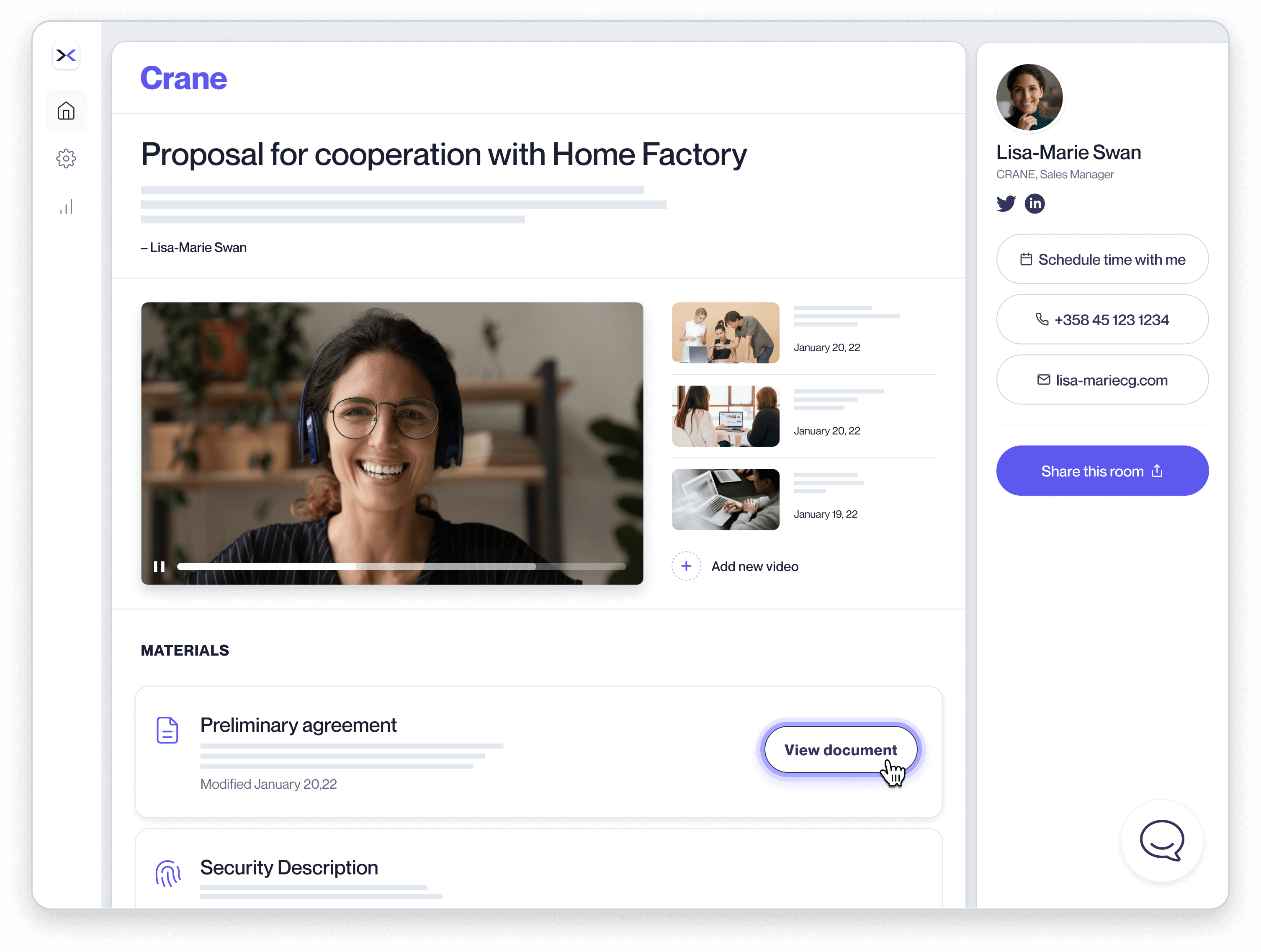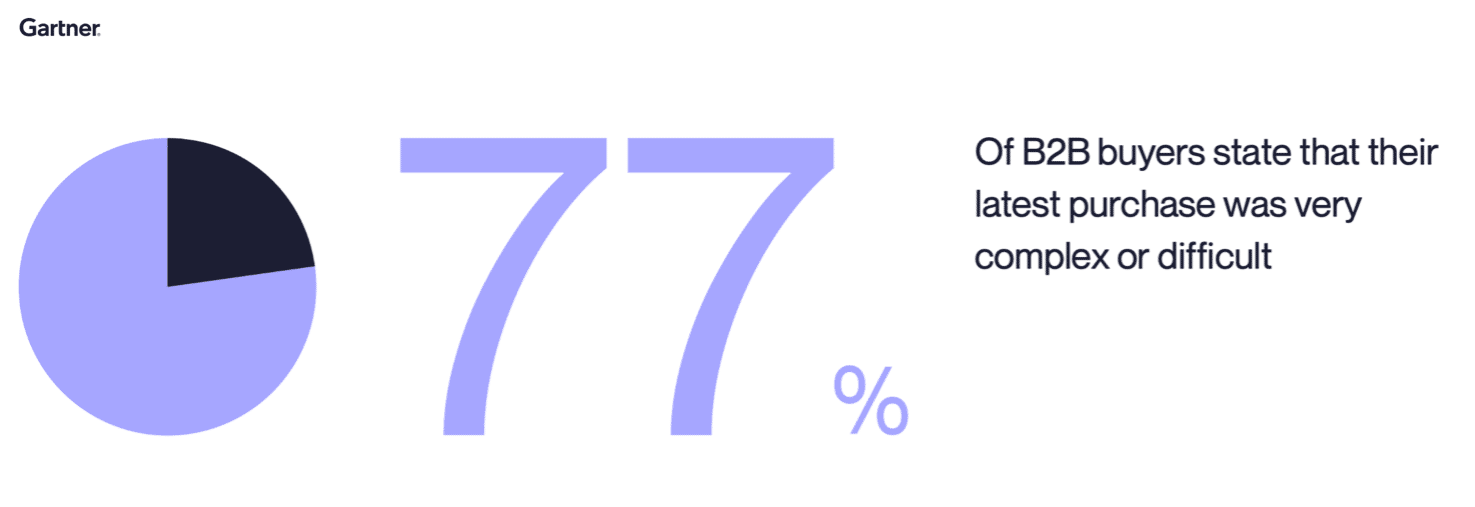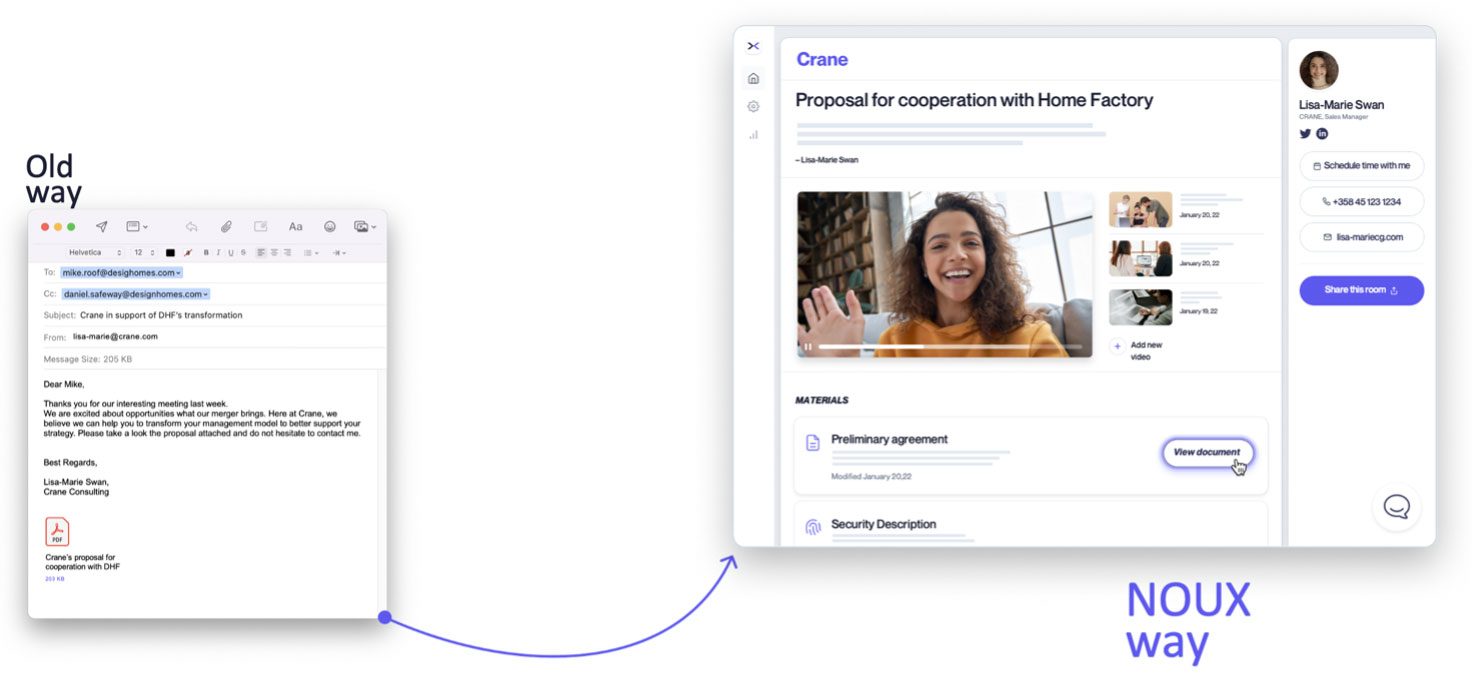Digital Sales Room – Introduction
Digital Sales Rooms (DSR) address the most significant challenges sales organizations face – getting potential customers excited and engaged. There’s a reason for the rapid growth of Digital Sales Rooms: they can significantly improve sales results when used correctly.
DSR is a relatively new concept, and its description varies greatly depending on the perspective of the definer. Conceptually, the Digital Sales Room falls under the Sales Engagement umbrella category.
In a nutshell, DSR refers to the interaction between the salesperson and the potential customer during the sales process, and Digital Sales Rooms enhance and improve this interaction. The way these applications work and approach the topic varies widely.
This whitepaper presents our perspective on the features and benefits of typical Digital Sales Rooms.
What is the role of the Digital Sales Room?
Digital Sales Rooms act as a bridge between the salesperson and the potential customer.
Digital Sales Rooms aim to improve the salesperson’s workflow and the customer’s buying experience – thus improving B2B sales results.
Digital Sales Rooms help salespeople shift their work’s focus from internal tasks to tasks that enhance the customer experience and interaction.
The most tangible manifestation of sales engagement platforms for the customer is the digital sales site that aggregates sales content and communication: The Digital Sales Room. In the Digital Sales Room, communication occurs through different channels, such as email, social media, chat, and phone, depending on the customer’s priorities.
Digital Sales Room guides the salesperson in various sales process steps, from suggesting the proper contact time to providing data on customer activity.
By centralizing documents and communications on a single customer-facing site, sales managers and executives have access to data on purchasing behaviors. They can better identify which actions are most effective at each stage of the buying process. The information allows companies to improve their sales practices and communications.
Digital Sales Rooms can also automate activities such as appointment scheduling, reminder messages, and other activities previously done manually by the salesperson.
Videos have become an increasingly important part of Digital Sales Rooms, as they have significantly impacted customer interest, trust, and engagement. In this context, videos are primarily short, customized videos filmed by the salesperson to support the proposal and other content.
Digital Sales Rooms are not a replacement for Customer Relationship Management (CRM) systems but are designed to integrate with them.

Digital Sales Room Glossary
Sales Engagement
Sales engagement is used to describe the communication between salespeople and potential customers.
It includes all interactions from the initial conversation with a potential customer, through to the meeting and offers, to the negotiation, and, finally, to signing the contract.
Sales Engagement Platform (SEP)
Sales engagement platforms serve as a sales tool to plan, implement, monitor, measure, and optimize the interaction between salespeople and potential customers across multiple contexts and channels. The platforms aim to improve the buying experience by facilitating communication, updating, and sharing materials.
Sales engagement platforms integrate with CRM systems.
Sales Enablement
Sales Enablement provides the sales organization with information, content, and tools to help salespeople sell more effectively.
Sales enablement is, therefore, about supporting the sales team, while sales engagement is more clearly about deepening and optimizing customer interactions. Digital Sales Room
Alternative terms: Virtual Sales Room, Digital Sales Site, Sales Site, Customer Site, Customer Portal, Collaboration Room, Communication Hub.
A Digital Sales Room allows a salesperson to create a seamless and personalized buying experience for the customer by bringing together all sales materials and communications in an engaging format. For example, the Digital Sales Room can contain offer, contract documentation, and other additional information to support the buying decision. It can also include a chat, a seller’s calendar, testimonials, and the ability to share the Sales Room with colleagues.
Digital Sales Rooms are tailored to the individual customer or client company, unlike, for example, a company website, which is essentially the same for all visitors.
Buying Group
Digital Sales Rooms help the salesperson communicate with the primary customer contact and support the buying process of the entire team involved in the buying process. The buying group is the team of people involved with the purchase on the customer side. According to Gartner, a typical B2B buying process involves eleven people.
Buying Journey / Customer Journey
The B2B buying process is typically understood as the stages of the service procurement process. In sales organizations, development has been dominated by the sales process, but the focus is shifting to the buying journey.
The buying process varies significantly according to the customer and is rarely linear.
The typical stages of B2B buying
- Recognizing the need or problem to be solved. “We must do something. “
- Searching for a solution. “What options exist that can solve our problem?”
- Defining the requirements. “What do we need specifically?”
- Comparing providers. “Does this solution offer what we’re looking for?”
- Validation. “We believe we have the right answer, but we must be sure.”
- Creating consensus. “We must get everyone on board.”
Why is Digital Sales Room a hot topic?
Driven by digital buying behavior, procurement dynamics are changing rapidly, forcing sales organizations to change their strategic focus. However, only a few sales organizations react quickly enough.
The year 2020 saw significant changes to the way we work. B2B sales have not escaped major changes either. In recent years, face-to-face meetings have been replaced by digital meetings and remote selling. This change will likely be permanent in many industries. This will require new approaches to building customer relationships.
At the same time, competition has gone global, and customers expect more value and expertise from providers.
While the internet has changed the world of sales, the basics of sales have remained the same. The key role of the salesperson is to help and build trust with the customer. This is best done by listening to and understanding the customer, being proactive, and using your personality to win their trust.
The first Digital Sales Rooms have been on the market for more than a decade, but in recent years, sales organizations have realized their benefits.
Buying is hard
According to Gartner, a typical buying group involved in procuring a B2B solution consists of over ten decision-makers. Each decision-maker collects information independently and shares it with the buying team. At the same time, the selection of solutions the team can choose from grows as new technologies, products, vendors, and services come to the market.
This dynamic is making it increasingly difficult for customers to make purchasing decisions. More than three-quarters of clients surveyed by Gartner described their most recent B2B purchase as very complex or challenging.

This means that buyers increasingly value suppliers who make the buying process easier.
“As hard as it has become to sell in today’s world, it has become that much more difficult to buy. The single biggest challenge of selling today is not selling; it is actually our customers’ struggle to buy.”
Brent Adamson
Distinguished VP, Advisory, Gartner
The time buyers spend with salespeople is decreasing
The unfortunate truth for sales professionals is that they have minimal ability to influence the customer’s buying decision. As digital channels provide easily available quality information, buyers have become empowered to seek knowledge independently, so sellers have fewer opportunities to influence the customer’s decision.
According to Gartner’s research, B2B buyers spend only 17% of their time meeting potential suppliers when considering a purchase. When comparing multiple suppliers, buyers spend only about 5% of their time with one supplier.
The salesperson is, thus, no longer the essential information source in the eyes of the customer – just one among others. Customers are increasingly taking the initiative to obtain information from public sources. According to a Gartner study, 43% of B2B buyers prefer to interact and gather information without direct contact with the sales rep. It is worth noting that among millennials, having grown up in the e-commerce era, the figure is already 54%.
The limited time spent together between the customer and the seller poses a challenge to building trust. Sales engagement platforms enable more value-adding touchpoints and help build trust through digital means.
The adoption of Digital Sales Rooms is growing
The key reason for the rapid growth of sales engagement platforms is apparent – they pay for themselves. A Gartner study finds that sales engagement platforms are the top-ranked technologies in terms of return on investment.
In this light, it is understandable that, according to Aragon Research, Sales Engagement Platforms will soon emerge as a key investment for large enterprises. The strong growth of sales engagement platforms and Digital Sales Rooms is believed to be due to their obvious benefits in sales development.
Leading sales organizations have started to shift their focus from increasing the number of customer contacts to improving the quality of customer communications. Indeed, the key benefit of most Digital Sales Rooms culminates in a multi-faceted improvement of the customer’s buying experience.
What’s in Digital Sales Room for me?
Digital Sales Rooms deliver value both to the end customer and to all those who are in contact with the customer, such as sales managers, sales developers, and sales executives. The benefits of Digital Sales Rooms for different roles are discussed below.
The Sales Director
The focus of Sales Directors is dominated by managing the numbers related to different stages of the sales process. As a result, many spend too little time monitoring and improving the quality of sales work at the quotation stage.
According to a Bain & Company study, time spent with a manager rarely creates value for US and UK salespeople. This is especially true if the manager is oriented toward sales processes and management models. What salespeople find valuable is the time spent with their manager developing sales and customer plans.
Digital Sales Rooms provide an excellent additional tool for the sales directors to audit and improve the communication between the salesperson and the customer.
As competition has intensified, it has become more expensive to obtain customer encounters, so investing in individual customers is justified. The focus of sales management is shifting from managing the number of customer encounters to improving the quality of customer encounters.
B2B sales have been changing so rapidly due to digitalization and global competition that sales managers have neglected the other side of the coin, the B2B buying process. This is supported by Gartner’s finding that most sales teams still have a sales process-centric mindset. Digital Sales Rooms help sales management to shift the focus from the sales process to the customer buying process.
The sales rep
Sellers put a lot of effort into offers, but don’t get data or feedback on whether they are opened, read, or liked. Digital Sales Rooms provide all this information and enable not only the development of individual customer relationships but also the development of overall relationships through data.
A large proportion of the sales rep’s time is spent reaching out to customers – and timing is often a guessing game. With Digital Sales Rooms, customers have easy access to the sales rep, for example, via chat. In addition, buying group members can book appointments directly within the sales rep’s calendar.
Another advantage of Digital Sales Rooms is that they can remind and inform sales reps of when they should contact the customer. The result is that they spend less time contacting buyers and more time on value-adding interactions.
One of the key benefits of using Digital Sales Rooms is that they lower the threshold for sales reps to use personalized videos as part of their customer communication. Videos can be used to generate interest and increase trust. In addition, videos help humanize the buying experience.
Marketing
One of the major advantages of using a Digital Sales Room is that it allows for more systematic identification of the customer’s buying group members.
Although a customer’s buying group typically includes several decision-makers, salespeople often have only the most important contact recorded in the CRM system. When salespeople start using a salesroom that identifies all members of the customer buying group, a broader set of contacts will be available to marketing.
This enables marketing to market during the sales phase, for example, via social media. Re-targeted marketing during the sales phase can make a big difference.
The customer
The primary beneficiary of Digital Sales Rooms is the end customer – if this is not the case, the core value proposition of Digital Sales Rooms is not realized.
The buyer can easily find multiple suppliers but wants the right one to be easy to choose. A well-managed and clearly articulated sales process reduces the customer’s sense of risk and creates confidence that the post-sale redemption phase will go smoothly.
At the same time, comparing suppliers has become more straightforward with online meetings and online information, and the customer’s trust in the seller often falls by the wayside during remote selling. This may help explain Gartner’s estimate that nearly 50% of B2B proposals fail to make a yes or no decision. A complicated or confusing buying process leads customers to leave even an unexamined initial investment idea.
When a potential customer does not understand the value of the service offered by the seller – and lacks confidence in their ability to deliver the value they want – the result is often a no-decision situation. By improving trust, communication, and systematic sales development, sales engagement platforms can reduce these occurrences of indecisiveness.
Digital Sales Room reduces obstacles to conversion
As we mentioned above, making purchasing decisions is hard. Gartner has assessed the most frustrating factors in B2B buying journeys. By understanding these factors, we can look at how Digital Sales Rooms can reduce the causes of frustration.
The five most common sources of frustration in B2B buying
- Difficulties in finding specific information
- Getting pushed to buy when the customer is still learning about available solutions
- Too many follow-up communications
- Challenges in comparing solutions objectively
- Being pressured to move forward before the customer has assessed key information
Digital Sales Rooms address the top frustration of the difficulty of finding information, as all relevant and up-to-date information can be compiled in a Digital Sales Room that can be shared with all members of the buying group.
Overall, the three most common causes of frustration in the buying process reflect a pressurized approach to sales. There is a fine line between pressure and proactivity, a constant debate in sales.
Digital Sales Rooms give the salesperson a better picture of the customer’s progress and readiness, allowing them to time their communications better. A good example is when the salesperson is informed that the customer has just seen the offer and calls the customer to serve them at the most relevant moment.
Digital Sales Rooms do not meet the challenge of facilitating comparison between competitors. Still, they can help providers differentiate themselves in a positive light in the eyes of the customer compared to competitors who communicate in traditional ways.
The features and benefits of a Digital Sales Room
Digital Sales Room allows you to create a seamless and personalized buying experience for your potential customer by gathering all sales material and communications in a Digital Sales Room in an engaging format. The features and benefits that enable this and are typically found on these platforms are described in more detail below.
From emails attachments to Digital Sales Room
PDF files attached to emails have been the dominant way of submitting sales proposals since the demise of paper tenders in the 1990s, which still applies to most sales organizations. A key feature of Digital Sales Rooms is to gather all sales content and communications on a single page rather than sharing attachments. The key benefits of this model are:
- The offer document can be updated in real-time
- The customer can share with other members of the buying group a link to the Digital Sales Room instead of an attachment
- The seller can control who has access to the Digital Sales Room
- The seller can see which members of the buying group are viewing documents.
- The seller can see when files are opened and read

Sharing Digital Sales Room with the buying group
In B2B sales, purchase decisions are often made by a group of buyers rather than a single buyer. However, the general pattern in B2B sales is that the seller communicates mostly with a so-called primary contact, who tries to express the seller’s ideas and shares attachments with his colleagues. The challenge with this model is the confusing communication and the fact that some people in the buying group can feel left in the dark regarding information sharing and perceive the service as less valuable.
The buying group experience is significantly enhanced when a potential customer can conveniently share a Digital Sales Room with other buying group members, containing all up-to-date documentation. As the buying process moves towards supplier selection and consensus creation, the seller who has been able to win over the entire buying group has a greater chance of winning the deal.
Personalizing buying experiences
At their best, Digital Sales Rooms drive the sales culture so that documents and interactions are more customer-centric.
A Digital Sales Room does not guarantee that the salesperson is not talking about themselves and their unique offering. However, these platforms encourage putting oneself in the customer’s shoes and focusing more and more on understanding the customer’s situation and solving their individual customer needs.
Engaging customers with video
Digital Sales Rooms enable and encourage salespeople to communicate with short videos.
Videos have entered the B2B sales communication palette with a blast – and for a good reason! The value of video has long been recognized in consumer marketing, where it has become a vital attention-grabber and customer engagement tool. Now, B2B sales are tapping into this same benefit.
In the age of remote selling, face-to-face encounters have reduced significantly. Video can increase personalization and trust and make the selling experience more attractive to the customer.
A typical example of a personalized sales video is a clip accompanying the delivery of an offer. The salesperson spends around a minute or two explaining the customer’s need and the main idea of collaboration. Other good examples of video use include proposal walkthrough videos, meeting recordings, product demos, and reference videos.

Tracking offer read and open rates
With a Digital Sales Room, the salesperson can gain insight into a potential customer’s behavior by tracking what content they view and how much time they spend on it.
This allows the salesperson to engage with customers when they are already actively engaged.
It is far more effective to engage with a customer once they have familiarised themselves with the sales materials than to call them randomly and ask: “Have you had a chance to look at the offer I sent you?”
When a salesperson sees that a potential customer is spending time with an offer or other materials, the Digital Sales Room relays the information to the salesperson, who then can engage with the customer at the right time.
Data on customer stages and interest
Digital Sales Rooms can provide data on customer behavior. The salesperson can also see all open accounts and which sales stages they’re in so they can target their resources where it most makes sense.
Digital Sales Rooms can provide data on areas such as:
- The time customers on an offer, overall and by page
- The time customers spend on other materials and links
- The average size of the buying group per customer
- The duration of the offer phase from offer to conversion
Automating reminders
Did a potential customer forget to read your offer? Or did you forget to contact the customer and ask them to sign the contract?
Digital Sales Rooms often include automatic reminders to improve open document rates and prevent sales opportunities from slipping away.
On the marketing side, automated follow-up messages to customers who have not responded to messages have been the default approach for over a decade. In sales, however, many salespeople send an offer by email and hope for the customer’s responsibility.
An example of automation provided by Digital Sales Rooms is when a salesperson emails a customer a link to a new offer, and a reminder is scheduled to be sent, for example, three days after if the customer has not opened the link.
Sharing documents safely
The risk with email attachments is that they can be shared with the wrong people. The Digital Sales Room helps keep important presentations safe with access management. The salesperson can manage access levels, share information with a prospect or colleague, revoke access, and limit downloads.
The Digital Sales Room allows the salesperson to replace, delete and update the most appropriate content at any time. For example, you can correct errors without sending a new attachment to the customer.
New ways of communicating with the customer
A Digital Sales Room enables members of a potential customer’s buying group to interact with the seller in various ways. Some customers prefer traditional telephone contact. Some like to chat, some connect on LinkedIn, while others book a remote meeting directly in the Sales Room.
Making the salesperson’s calendar accessible to the customer
All sellers are familiar with setting up a meeting by sending appointment requests back and forth by email. It takes up valuable time for both the customer and the seller.
Digital Sales Rooms offer modules that allow the salesperson to share the available times in their calendar directly with the customer, enabling easier appointment booking.



